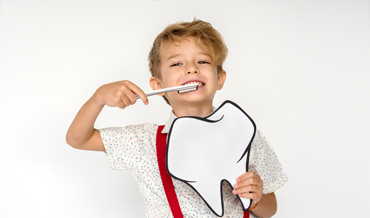
How to Care for Your Child’s Teeth
How to Care for Your Child’s Teeth
Healthy teeth are important to your child’s overall health. They help your child eat and talk. Strong oral care helps set good dental habits as your child grows. Poor oral care can lead to infection, disease, or other teeth problems.
Help make dental hygiene fun with these tips:
- Let children help choose their own toothbrush. They can pick one that has a favorite color or character.
- Let children help choose toothpaste. They can pick their favorite flavor.
- Read books or watch videos that talk about dental hygiene.
- Use a timer to make sure kids brush their teeth for 2 minutes. Or play their favorite song to help keep track of time.
- Reward children for good oral care. Do not give them food or sugary treats. Offer something healthy or simple instead, like apple slices or a gold star.
- Plan a fun activity following your child’s dentist visit.
Path to improved health
The role of fluoride
Fluoride is important to your child’s dental health. It is known to reduce cavities in baby (primary) teeth and adult (permanent) teeth. It also helps make teeth strong by hardening the tooth enamel. Most children get fluoride in drinking water. Many cities are required to add fluoride to tap water. Water filters, such as Brita, do not remove fluoride and are okay to use. You should not use “reverse osmosis” water filters.
If your water does not contain fluoride, your child may need to take an oral fluoride supplement. Talk to your doctor to see if your child needs this. Once your child starts going to the dentist, they will get a fluoride varnish or cleaning on their teeth.
Too much fluoride can cause tooth stains and be harmful to your child’s health. Be sure your child does not swallow fluoride toothpaste or mouthwash. Follow all instructions for fluoride supplements.
Brushing and flossing
Dental hygiene should begin when your child is a baby. Start using a soft child-size toothbrush around the age of 1 or 2. You should brush your child’s teeth with water at least twice a day. You also can add a small dab of toothpaste that doesn’t have fluoride in it. This type of toothpaste is safe for your child to swallow. Once your child is old enough to spit out the toothpaste, you can switch to one that has fluoride. Only use a small amount. Teach your child to spread it among their teeth, gums, and tongue. Have your doctor or dentist show you the right way to brush your child’s teeth.
Your child likely will need help brushing their teeth until they are 7 or 8 years old. Around this time, they can start using a larger sized toothbrush. You should switch out toothbrushes every 3 to 6 months or when the bristles look worn. Children should brush their teeth for 2 minutes. Flossing is another key part of your child’s oral care routine. Teach your child to floss at least once a day. You can buy floss that comes on a handle to make it easier.
You should also teach your child to brush his or her tongue. This helps reduce the amount of bacteria in the mouth.
Be sure that your child knows to brush his or her teeth before bed, after all eating and drinking (except water) is done.
Cavities
Cavities are holes that form in your teeth. These can occur when bacteria (germs) build up in your mouth. Sugar in food and drinks turn into acid, which can eat away at your teeth. Cavities are common in children because their teeth can be harder to brush. Everyone in your family should take good care of their teeth. People who have cavities can pass the cavity-causing bacteria to unborn babies, infants, and children.
Your child may be at risk for cavities if they:
- Have white spots or brown areas on their teeth.
- Have ongoing special health care needs.
- Do not go to the dentist often.
- Were born early (premature) or had a low birth weight.
Diet
Kids who eat a lot of sugary foods and drinks also are at high risk for cavities. It is important to make healthy food choices. Avoid too much sugar. Do not let your child have a lot of soda, fruit juice, or sweetened drinks. Limit sweet snacks and drinks between meals. If your child does have sugar, make sure they brush their teeth afterward.
Chewing gum is safe for older kids. It can provide benefits, such as:
- Strengthening the jaw.
- Helping produce saliva.
- Washing away bits of food.
- Balancing acid that can cause tooth decay.
- Freshening breath.
However, gum that contains sugar can cause cavities. Limit the amount of sugar gum your child chews or only give them sugar-free gum.
Mouth safety
Safety is another big part of dental hygiene. If your child plays sports, they should wear a mouth guard. This is a soft, plastic retainer that covers the teeth and sometimes the lips. It helps protect your child’s mouth from injuries. Talk to your dentist if you need a custom-fit mouth guard.
From baby teeth to adult teeth
In general, baby teeth start to appear between 4 and 7 months old. The first teeth to come in are usually the 2 bottom front teeth. Most kids have all 20 baby teeth by about 3 years of age.
Children can lose their baby teeth as early as 6 years old and as late as 12 years old. During this process, your child has a mix of teeth as baby ones fall out and adult ones break through. Around this time, your dentist may talk to you and your child about possible teeth problems. Some kids need orthodontia treatment, such as braces. A full set of adult teeth is 32 teeth. This includes wisdom teeth, which most people do not get until their late teens or early adulthood.
Things to consider
It’s normal for babies to suck their thumbs, their fingers, or a pacifier. Most children give up this habit on their own by age 4. Prolonged use can cause problems with teeth alignment. Talk to your dentist if your child still has a sucking habit after age 4. They can watch for problems as your child’s teeth develop. In most children, there is no reason to worry about a sucking habit until around age 6, when the permanent front teeth come in.
When to see a dentist
The American Academy of Pediatric Dentistry (AAPD) recommends that children see a dentist around their first birthday. This gives the dentist a chance to look for early problems with your child’s teeth. Pediatric dentists specialize in treating children’s dental health. The dentist will talk to you about proper oral care.
Visiting the dentist from a young age will help your child be more comfortable. It also establishes the good habit of regular dental checkups. Everyone should see the dentist twice a year.
Contact your dentist right away if:
- Your child has tooth pain or a tooth or mouth infection.
- Your child loses a permanent tooth. If you find the tooth, put it in milk and take it to the dentist with you. They may be able to reattach it.
Questions to ask your doctor
- Does my child need to take oral fluoride supplements?
- What is the best type of toothbrush for my child?
- Can my child use mouthwash?
- Is my child at high risk for cavities?
- How often should my child visit the dentist?
- Are dental X-rays safe for my child?
- Is it okay for my child to chew gum?
Have Dental Problem : Call us
CALICUT: +91 9745 072 555,
KOCHI: +91 9567 124 888
KANNUR: +91 9645874777
or make an Appointment
Take a smiling selfie and we'll Simulate your new smile See What Invisalign treatment could do for you!




